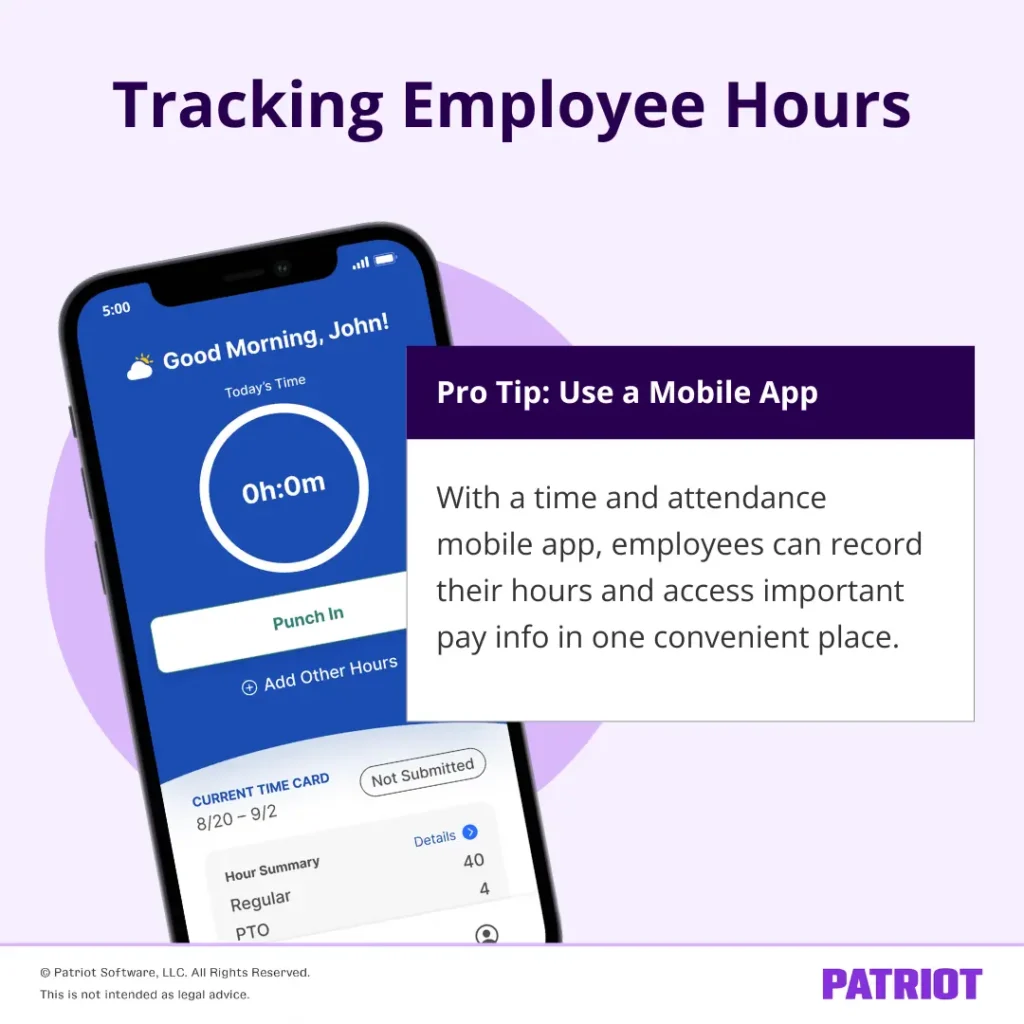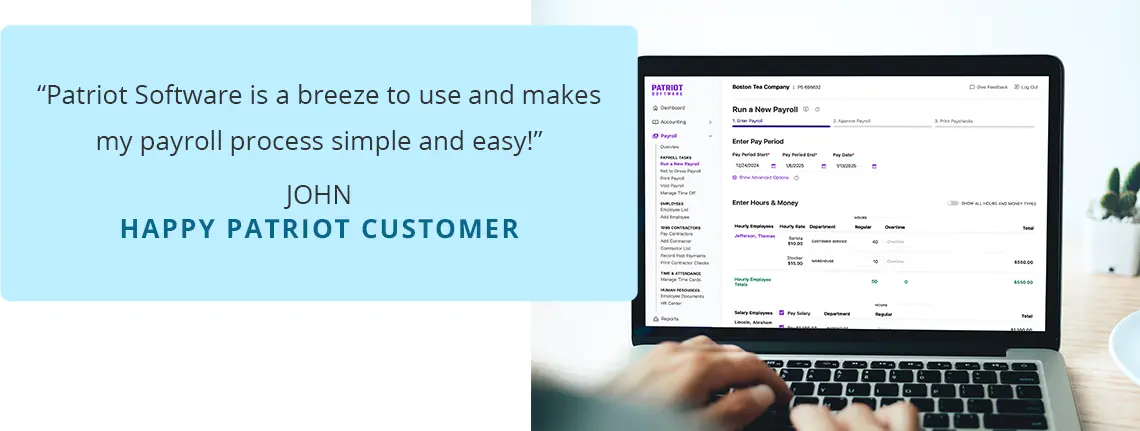Tracking your employees’ time worked ensures you pay them accurately and comply with labor laws. Although you can use whatever method you want, you need a dependable and organized system, especially as your business grows. Learn how to track employee hours with time and attendance software and other alternatives.
Why does tracking employee hours matter?
Tracking employee hours is essential for payroll accuracy, legal compliance, and improved organization.
Every employer should track employee hours for the following reasons:
1. Tracking employees’ time is key to payroll accuracy
Accurate payroll ensures you pay employees what they’re owed and comply with legal requirements. Not to mention, accurate payrolls limit payroll errors.
Payroll errors lead to penalties and wasted time. You can reduce payroll errors by paying employees correctly the first time around.
2. The FLSA requires timekeeping
Under the FLSA, covered employers must keep records of employee hours worked each day and workweek.
The FLSA doesn’t care how you keep your employees’ time so long as your timekeeping records are “complete and accurate.”
3. Timekeeping ensures you pay overtime
Under the FLSA, nonexempt employees are entitled to time and a half for hours worked beyond 40 in a workweek. Overtime laws by state may have different requirements. For example, you may need to pay overtime to employees who work beyond a certain number of hours per day.
Know when employees work overtime hours—aka when they’re entitled to time and a half pay—with accurate timekeeping.
4. Accurate time tracking prevents time theft
Are employees working when they say they are? Time theft is when an employee says they worked when they did not. The employee receives their regular pay even though they did not work or use paid time off.
Time theft can cost businesses hundreds or even thousands of dollars per year.
Efficiently track employees’ time to hold your team accountable and help mitigate time theft problems.
How to track employee hours: Methods
Again, the FLSA doesn’t require businesses use any one method for tracking employee hours. The FLSA gives examples of using a time clock, having timekeepers track hours, or having employees record their hours.
Some timekeeping systems have advanced features, such as the use of facial recognition, iris scans, or fingerprint technology.
Whatever system you use, you need a complete and accurate way to track employee hours worked and time-off hours.
Common timekeeping methods include:
- Time and attendance software
- Punch clocks
- Pen and paper
- Spreadsheet
1. Time and attendance/timekeeping software
Timekeeping software, or time and attendance, lets you track and manage employees’ work hours online.
Features include the ability to:
- Clock-in and clock-out online
- Customize overtime rules to comply with company policies or state mandates
- Nudge employees about incomplete time cards
- Integrate with payroll software so you can quickly send approved hours to payroll
- Access time card history and summary reports
Some timekeeping systems have a mobile app so employees can log hours worked, check balances, leave comments for managers, and view recent pay in one convenient place. Your timekeeping system may even have a geotagging feature so you can track employees’ clock-in and clock-out locations.
Consider using time and attendance software to streamline how you track employee hours and run payroll.

2. Punch clocks
Some businesses have a punch clock in the workplace. Employees punch in when they come to work and punch out when they leave for the day.
Punch clocks can help you track employee hours, but be aware that this is where the term “buddy punching” comes from. Buddy punching is a type of time theft where an employee asks a coworker to punch in for them.
3. Pen and paper
You can have employees manually record their hours on paper. However, pen and paper can increase the chance of time theft, errors, and disorganization.
Not to mention, you need to gather hours each pay period so you can run payroll. You may spend extra time tracking down paper records and nudging employees to record their time.
4. Spreadsheet
Employees can log their hours using a spreadsheet (e.g., Google Sheets or Microsoft Excel). You can set up formulas to streamline the process of calculating hours worked.
However, you still need to manually enter employee work hours into your payroll system, which can take time and lead to data entry errors.
How to track employee time: Getting started
Ready for a better way to track your employees’ hours?
Here are some simple steps to get started:
- Choose a system: Compare your options. Weigh factors like price, usability, and payroll integration when choosing your time-tracking tool.
- Set up your system: After you’ve decided on a timekeeping system, you’ll need to set it up with information like your workweek start date, company-specific overtime rules, etc.
- Give employees access: Let employees know about your system, give them proper access, and train them to use it.
- Troubleshoot issues: Employees may have questions after they get set up. Be available to address questions and troubleshoot issues.
How do I keep track of my employees’ hours?
You can track employees’ hours with any timekeeping method you choose, according to the FLSA. This includes time clocks, pen and paper, and time and attendance software.
Many employers opt to track employees’ hours with time and attendance software. With time and attendance software, you can:
- Have employees log hours or punch hours
- Send hours worked to payroll (if a payroll integration is available)
- Customize overtime rules to comply with your company or state rules
- Generate time summary reports
How do small businesses track hours?
Every business differs, but many small businesses use simple timekeeping software, manual recording, or time clocks.
Consider your company’s needs and time commitment when choosing how to track employee hours.
How do teams track employee hours?
Teams may prefer using timekeeping software that lets managers view and approve their teams’ time cards.
For example, Patriot’s time and attendance software comes with manager permissions that let managers view, nudge, approve or reject, and edit direct reports’ time cards. That way, you’re not responsible for managing all the time cards across your entire small business.
Who is responsible for tracking employee hours?
Employers are responsible for tracking employee hours and keeping accurate and complete records.
You can delegate responsibilities to payroll administrators, your HR team, and/or department managers.
Related Article: Can employers change time cards?
Can you track employee hours in Patriot Software?
Yes! Patriot’s time & attendance software is a great timekeeping solution for businesses that use Patriot’s payroll software.
The payroll software add-on lets you track and approve employee time cards and send work hours to payroll, saving you time and effort.
Plus, employees can use Patriot’s timekeeping app to:
- Log worked and time-off hours
- Check available balances
- Leave comments for managers
- View recent pay
You can sign up for a free trial of Patriot’s online payroll and time & attendance software add-on here.
This is not intended as legal advice; for more information, please click here.



